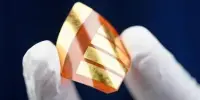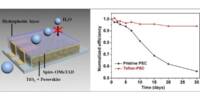According to a new study, light can cause evaporation at the interface of water and air in certain conditions without the need for heat. Evaporation occurs continuously all around us, from sweat cooling our bodies to dew burning off in the morning sun. However, science’s understanding of this pervasive process may have been incomplete all along.
Some researchers have been perplexed in recent years after discovering that the water in their experiments, which was held in a sponge-like material known as a hydrogel, was evaporating at a faster rate than could be explained by the amount of heat, or thermal energy, that the water was receiving. And the excess has been significant – a doubling, or even a tripling or more, of the theoretical maximum rate.
A team of researchers at MIT has reached a startling conclusion after conducting a series of new experiments and simulations, as well as reexamining some of the results from various groups that claimed to have exceeded the thermal limit: under certain conditions, at the interface where water meets air, light can directly cause evaporation without the need for heat, and it does so even more efficiently than heat. The water in these experiments was held in a hydrogel material, but the researchers believe the phenomenon could occur under other conditions as well.
The findings are published in a paper in PNAS, by MIT postdoc Yaodong Tu, professor of mechanical engineering Gang Chen, and four others.
We tested it under our solar simulator, and it worked. So, we believed them now, then started developing and testing their own hydrogels.
Yaodong Tu
According to the researchers, the phenomenon may play a role in the formation and evolution of fog and clouds and thus should be incorporated into climate models to improve their accuracy. And it may play an important role in many industrial processes, such as solar-powered water desalination, potentially enabling alternatives to the step of first converting sunlight to heat.
The new findings come as a surprise because water itself does not absorb light to any significant degree. That’s why you can see clearly through many feet of clean water to the surface below. So, when the team initially began exploring the process of solar evaporation for desalination, they first put particles of a black, light-absorbing material in a container of water to help convert the sunlight to heat.
The team then discovered the work of another group, which had achieved an evaporation rate twice the thermal limit – which is the maximum amount of evaporation that can occur for a given input of heat, based on basic physical principles such as energy conservation. Water was bound up in a hydrogel during these experiments. Despite their initial skepticism, Chen and Tu began their own hydrogel experiments, including a piece of the material from the other group. “We tested it under our solar simulator, and it worked,” Chen says, confirming the unusually high evaporation rate. “So, we believed them now.” Chen and Tu then started developing and testing their own hydrogels.
They began to suspect that the excess evaporation was being caused by the light itself — that photons of light were actually knocking bundles of water molecules loose from the water’s surface. This effect would only take place right at the boundary layer between water and air, at the surface of the hydrogel material — and perhaps also on the sea surface or the surfaces of droplets in clouds or fog.

In the lab, they monitored the surface of a hydrogel, a JELL-O-like matrix consisting mostly of water bound by a sponge-like lattice of thin membranes. They measured its responses to simulated sunlight with precisely controlled wavelengths.
The researchers subjected the water surface to different colors of light in sequence and measured the evaporation rate. They did this by placing a container of water-laden hydrogel on a scale and directly measuring the amount of mass lost to evaporation, as well as monitoring the temperature above the hydrogel surface. The lights were shielded to prevent them from introducing extra heat. The researchers found that the effect varied with color and peaked at a particular wavelength of green light. Such a color dependence has no relation to heat, and so supports the idea that it is the light itself that is causing at least some of the evaporation.
The researchers tried to duplicate the observed evaporation rate with the same setup but using electricity to heat the material and no light. Even though the thermal input was the same as in the other test, the amount of water that evaporated never exceeded the thermal limit. However, it did so when the simulated sunlight was on, confirming that light was the cause of the extra evaporation.
Although water and hydrogel materials do not absorb much light on their own, Chen claims that when the two are combined, they become powerful absorbers. This enables the material to efficiently harness the energy of solar photons and exceed the thermal limit without the use of any dark dyes for absorption.
The researchers are now working on how to apply this effect, which they have dubbed the photomolecular effect, to real-world needs. They have a grant from the Abdul Latif Jameel Water and Food Systems Lab to investigate how this phenomenon can be used to improve the efficiency of solar-powered desalination systems, as well as a Bose Grant to investigate the phenomenon’s effects on climate change modeling.
Tu explains that standard desalination processes “normally have two steps: first, we evaporate the water into vapor, and then we need to condense the vapor to liquefy it into fresh water.” With this discovery, he believes “we can achieve high efficiency on the evaporation side.” The process may also find applications in processes that require the drying of a material.
Chen believes that by using this light-based approach, it may be possible to triple or quadruple the limit of water produced by solar desalination, which is currently 1.5 kilograms per square meter. “This could potentially really lead to cheap desalination,” he points out.
















